Browse RealFlight G2 Articles by Category
This Knowledge Base contains the articles pertaining to RealFlight G2. The links below will be used to navigate these items.
Pre-Sales
Answer
The RealFlight Generation 2 software is completely compatible with all Add-Ons disks. When used in conjunction with the RealFlight Generation 2 software, the Add-Ons disks offer the same flexibility, options and enhancements found on G2: high-resolution graphics, moving control surfaces and more!
As with a desktop PC, you must ensure your laptop meets or exceeds all the System Requirements for the version of RealFlight you intend to use. Since RealFlight is 3D accelerated, it is especially important that the display device on your laptop is designed to support graphics-intensive 3D games. Laptops intended for 3D gaming will be built with a video card rather than an integrated graphics processor. Gaming-capable laptops are typically marketed as "gaming laptops" or "multimedia laptops".
For more information regarding the expected performance of your laptop, please contact your laptop manufacturer.
Yes. It is in PDF format, so you may need to get Adobe Acrobat Reader DC software in order to view it.
If you would like to print all or part of the RealFlight G2 Manual, you can do so with your local printer.
Yes. It is in PDF format, so you may need to get Adobe Acrobat Reader DC software in order to view it.
If you would like to print all or part of the RealRace G2 Manual, you can do so with your local printer.
RealFlight is compatible only with Microsoft Windows and cannot be used with Mac OS/OSX operating systems. But if you can run Windows on your Macintosh computer, you should also be able to run RealFlight.
Apple now offers a program called "Boot Camp" that does allow Macintosh users to dual-boot Windows with Mac OS/OSX. For help installing Windows onto your Mac using Boot Camp, contact Apple Support.
An integrated graphics processor is a low power substitute for a video card and is not intended for resource intensive 3D games. Integrated graphics use shared system memory (RAM) for video memory and the central processor (CPU) for graphics processing. A video card has the dedicated video memory (VRAM) and graphics processor (GPU) needed for handling 3D games.
For more information regarding the expected performance of the display device on your laptop or desktop computer, please contact your system manufacturer.
The warranty period for all RealFlight products is 90 days from the date of purchase. The warranty covers product defects and any damage that occurs during shipping and handling from the original purchase.
Please note: The warranty is not transferrable, and does not cover second hand purchases.
Under the terms of the Limited Use Software License Agreement, one copy of RealFlight is licensed for one user. While RealFlight is licensed for one user, that user can definitely have it installed on more than one machine at a time. There is no need to deregister a computer.
In the event the user is not able to activate or register on a second machine, they can contact Software Support to request a registration reset for their number. This will allow them to re-register from the new computer.
Installation
Resolution
Occasionally users may experience difficulties when attempting to upgrade from RealFlight or RealFlight Deluxe. This situation generally occurs when:
- RealFlight Classic/Deluxe has been updated via the Internet
- Add-Ons 3 has been installed previously
To resolve these difficulties:
- Uninstall the RealFlight software completely. If you have already attempted to install the Generation 2 Upgrade disk, use the RealFlight Control Panel. Click the Start menu, select Program Files/RealFlight/ RealFlight Control Panel. Select the Uninstall RealFlight button. Click each of the boxes to ensure that ALL RealFlight files are removed from your PC. Click OK to remove the software accordingly. Additionally, we suggest that you check to make sure that the c:\program files\realflight directory is completely gone. If not, delete it manually.
- Reinstall the original RealFlight software. Do NOT run the program after installing. Note: If you are installing the software on a PC with Windows 2000, you will need the Install Fix. The installation fix is NOT needed for computers that use Windows XP.
- Remove the original RealFlight CD-ROM from the CD-ROM drive and insert the G2 Upgrade CD-ROM in its place.
- If applicable, reinstall any Add-Ons disks that you might have.
- Upon completing the installation of your software run the RealFlight G2 simulation.
Resolution
If the splash or loading screen appears momentarily on the screen and then disappears without continuing the setup procedure, it is necessary to access and download the installation fix. When downloading the file please make sure that the RealFlight CD-ROM is in the CD-ROM drive. Once the file has been downloaded to your PC, please run the installation fix. The installation procedure should proceed normally.
Resolution
If, during the installation process, the software ceases to respond after clicking Next, it will be necessary to delete the gpsn.vxp file from your hard drive.
If running Windows 95 or 98, the file may be found at: C:\windows\system\gpsn3.vxp.
If running Windows 2000 or XP, the file may be found at: C:\winnt\system32\gpsn3.vxp.
Upgrade/Update
Resolution
There are several possible causes for this difficulty.
Something might have gone wrong during the transfer of files from the web site to your PC. That is, the actual file transfer may have failed.
Check to make sure you have sufficient space on your hard drive. If the PC has sufficient space, clear the Download Cache and update the software once again. To do so, click the Start menu, select Program Files, RealFlight (or RealRace) and then the RealFlight Control Panel (or RealRace Control Panel). Click on the Online Update button followed by the Clear Download Cache button. Click Yes when prompted on the screen. Next, click Download Specific Version, select the latest version, and click on the Completely Refresh checkbox.
Alternately, a bug or difficulty might have been introduced with the updated download of the software. To verify this, return to the version of the software that you were using prior to noticing the difficulty. Click the Windows Start menu, select Program Files, RealFlight (or RealRace) and then the RealFlight Control Panel (or RealRace Control Panel). Click on the Online Update button followed by the Update to Specific Version option. From the list of updates, please select your previous version. If the difficulty still exists, then more than likely it wasn't something that was introduced by the simulator software. If, however, the difficulty is eliminated, try updating to the latest version of the software once again. If the difficulty is still apparent with the update it may be a bug in the software, Contact Us for further assistance.
Resolution
Occasionally users may experience difficulties when attempting to upgrade from RealFlight or RealFlight Deluxe. This situation generally occurs when:
- RealFlight Classic/Deluxe has been updated via the Internet
- Add-Ons 3 has been installed previously
To resolve these difficulties:
- Uninstall the RealFlight software completely. If you have already attempted to install the Generation 2 Upgrade disk, use the RealFlight Control Panel. Click the Start menu, select Program Files/RealFlight/ RealFlight Control Panel. Select the Uninstall RealFlight button. Click each of the boxes to ensure that ALL RealFlight files are removed from your PC. Click OK to remove the software accordingly. Additionally, we suggest that you check to make sure that the c:\program files\realflight directory is completely gone. If not, delete it manually.
- Reinstall the original RealFlight software. Do NOT run the program after installing. Note: If you are installing the software on a PC with Windows 2000, you will need the Install Fix. The installation fix is NOT needed for computers that use Windows XP.
- Remove the original RealFlight CD-ROM from the CD-ROM drive and insert the G2 Upgrade CD-ROM in its place.
- If applicable, reinstall any Add-Ons disks that you might have.
- Upon completing the installation of your software run the RealFlight G2 simulation.
Resolution
-
This might be due to the fact that the RealFlight software could not locate your serial number. If your controller is earlier than version 2.00.148, it is important to make sure that the RealFlight serial number appears in the Control Panel itself.
To determine the version of the RealFlight Control Panel you will need to access the Control Panel itself. Click the Windows Start button, then move your cursor to the Programs item, and then to RealFlight. Select the RealFlight Control Panel, and then click the Technical Support button. The control panel version will be located in the lower left corner of the display. The version number will be preceded by 'Cp Version'.
- Manually updating to the latest Control Panel will allow you to automatically connect to a secondary server once the program determines that the primary server has failed. Additionally, there is the option of manually overriding which server the program uses. To do so, click the Windows Start button, then move your cursor to the Programs item, select RealFlight and then select the RealFlight Control Panel. Click the Technical Support button followed by the Enter Tech Support Code and then type "USEBACKUPSERVER" (without using quotes).
- If your Control Panel is version 2.00.148 or later, then the server may be down. Please try to access the updates later. If the error message appears again, please Contact Us.
Resolution
In order to manually update the simulator's Control Panel your software must have a Control Panel to begin with. If your software does not already have the Control Panel, please update your respective software. This update will include a Control Panel.
To download the manual update of the simulator's Control Panel click on the link below. This should be used if you are having problems updating your software using the RealFlight Control Panel's Online Updating.
Note: If you are updating OK with the Online Update, then you probably don't need this update, as it is included automatically in the Online Update.
Download Now: Control Panel Update (1.1MB)
Resolution
You may be using an older version of the RealFlight Control Panel. Updating to the latest version will automatically access a secondary server should there be difficulties with the primary server.
To determine the version of the RealFlight Control Panel you will need to access the Control Panel itself. Click the Windows Start button, then move your cursor to the Programs item, and then to RealFlight. Select the RealFlight Control Panel, and then click the Technical Support button. The control panel version will be located in the lower left corner of the display. The version number will be preceded by 'Cp Version'.
There are two ways to update to the latest Control Panel:
- If possible, download the latest version of the RealFlight software using the Online Updating feature.
- Click on the Windows Start menu, select Program Files and then RealFlight.
- Click on the Control Panel.
- In the Control Panel click on the click the Online Update button.
To download the manual update of the simulator's Control Panel click on the link below. This should be used if you are having problems updating your software using the RealFlight Control Panel's Online Updating.
Download Now: Control Panel Update (1.1MB)
Cause
Due to network problems, compatibility with the connection from your computer to ours, or any number of network type issues could cause problems with connection to the G2 Registration Server.
Resolution
Knowing that there may be unforeseen issues connecting to the G2 Registration Server, we have created a secondary server as a back up. If you are experiencing problems connecting to the primary server through the RealFlight Control Panel, a message will pop up asking if you wish to connect to the secondary server. Click OK and try connecting again. You should find that you will connect just fine to the secondary server.
Version History
2.00.723
- ADDED: additional volume slider & on/off checkbox to Music/Sound dialog (read the pop-up tooltips for more info)
- FIXED: which volume sliders control which sounds (again, read pop-up tooltips on that dialog for info)
- FIXED: made "Look at Ground" setting persistent
- FIXED: changing views, camera positions, etc. will only turn off "Look at Ground" in specific cases
- FIXED: Control Panel removes Add-Ons 5 serial number on Uninstall, displays AO5 serial number in Technical Support dialog
2.00.717
- ADDED: Add-Ons 5 support
- ADDED: Lithium Polymer cell type
- FIXED: Shadow bug in recordings
- FIXED: Another general shadow bug
- FIXED: Recording bug resulting from playing a recording associated with a missing song file
- FIXED: Crash in modeless dialogs
- FIXED: Electric engine bug which caused cell recharge while idling
- FIXED: Collision bug where certain aircraft could occasionally pass through objects
- FIXED: Minor cosmetic fixes in dialogs
2.00.637
- ADDED: "Use alternate fog" option to solve lingering fog issues (white screen or no fog at all)
- FIXED: Fog bug with NVidia 44.03 drivers
- FIXED: "Lock to monitor refresh rate" option now retains its setting
- FIXED: Fog on/off setting for all individual airports now retained (must revert broken airports before this will take effect)
- FIXED: Twinstar airplane is now easier to land
- FIXED: Missing F4 preview pic on .594 discs
- FIXED: Add-Ons 1 & 2 CD verification problem on .594 discs
2.00.592
- Fixed NVidia driver conflict problem some users experienced
2.00.570
- FIXED: Control Panel crash on some computers
- FIXED: Some Multiplayer Hosting fixes
- FIXED: Three position switch for Interlink is now accessible
- Added Tail Rotor Reverse button to Heli Software radio page
- ADDED: RealFlight now compresses user's color schemes into DDS compressed textures
2.00.533
- FIXED: Transmitter interface wizard problem
- FIXED: Transmitter interface wizard problem
- FIXED: Initial aircraft position on some airports was bad.
- FEATURE: New Controller Calibration routines (For Transmitter Interface)
- FIXED: Multiplayer Host Server, fixed multiple bugs
- FIXED: KE 8342 Error that occurred on some computers
- FIXED: Startup is more reliable on some systems
- FEATURE: Original Disk not required every time program is run when the user has registered. May ask for it occasionally.
- FIXED: Position error fixed with PhotoField Graphics
- FIXED: Crash on startup for some people
- FIXED: Other small bugs fixed
2.00.386
- IMPROVED: RealFlight now starts faster
- ADDED: Instructions for manual install of the TX interface under Windows XP
- FIXED: Some Control Panel Bugs
- FIXED: Fog problem with some older cards
- FIXED: Drop Shadow for cursors is temporarily turned off while RealFlight executes to speed performance. This a Windows XP problem only.
- FIXED: Errors that occurred on some systems when switching from full screen to windowed mode.
- ADDED: RealFlight prompts for update check every 30 days
- FIXED: Control Panel out of memory on some computers
- FIXED: XP Reboot with TX Interface driver.
- FIXED: Control Panel and RealFlight crashes on some computers
2.00.327
- FIXED: Previews for F-15, Giles,and Extra now show up (Add-On 3 only)
- FIXED: Photofield version of Illinois Farmland now works correctly (Add-On 3 only)
2.00.321
- FIXED: RealFlight not starting on some systems
- ADDED: Spanish and Portuguese translations
- ADDED: G2 is now compatible with Add-Ons 3 (Sold Separately)
2.00.301
- FIXED: More fixes to the disk swapping problem
- FIXED: Crash sounds for remote players if you have the 'Play Crash Sounds' option turned on from the 'Options' menu item.
- FIXED: The most recently used IP list in the Join dialog will now hold 10 addresses.
- FEATURE: Added Freestyle event
- FEATURE: Added Auto-Rotation event
- FIXED: The Watt-Not faulting in Mplayer.
- FIXED: Minor fixes in Events
- FIXED: Crash sounds for remote players if you have the 'Play Crash Sounds' option turned on from the 'Options' menu item.
- FIXED: Saving of airports now correctly flags objects as being on the correct Add-Ons
- FIXED: Crash when loading older airports
- Added German Translations
- FIXED: Some airports load faster when trees are turned off
- FIXED: RF can now start without a joystick port
- FEATURE: Control panel now displays Release Notes after a download.
- FIXED: Renaming Heli Files now keeps the .heli extension
- FIXED: Under Windows 2000, sometimes ECP Printer Ports were not recognized
- FIXED: Provided a way to manually install the transmitter interface. See the ManualTX2000.doc in the RealFlight Control Panel Documents List.
- FEATURE: Added Auto-Zoom that makes aircraft larger. See View Menu/Viewport Options/View Tab
- FIXED: Plane no longer disappears behind clouds
- TWEAKED: Autorotations are better and FF is better. To improve accuracy even more, turn up Physics percentage in Misc/Options Dialog. 131% percent gives you about the highest bang for the buck.
- TWEAKED: Heli Forward Flight tweaks
- ADDED: 2 Types of Dolphin Helicopters, a normal one and a 3D one
- TWEAKED: Ground Effect for Helis
- FIXED: Transitional lift is better for helis
- TWEAKED: Heli Auto Rotations are not as "generous" as before
- TWEAKED: Climbout power from helis was reduced
- TWEAKED: Autos with helis are less forgiving at lower head speeds
- TWEAKED: Added more ground friction to helis
- TWEAKED: Stock helis had slight parameter changes such as collective to make it more representative of real world helis.
- Note on Heli Fixes: They were tested with the stock helis which were accurately measured from real helis. If you fly some of your old models that were "tweaked" to overcome some deficiencies in RealFlight, they may not fly as well with this version. So you may have to put back in the "real" parameters for your heli to get it to fly well again.
2.00.256
- FEATURE: Added Tree Collision
- FIXED: The landing gear for the Mustang as well as the other planes now records. There was also a problem with some of the more sophisticated flap systems.
- FIXED: Problems with sound profiles found in an add-on, and not available to other players
- FIXED: Problem in helicopter editor; electric motor selection now includes user-edited motors (affects heli only).
- FIXED: Changed the interface so that from the Main Window - Multiplayer - New Viewport For All Players will create a new viewport for each remote player.
- FIXED: When a chat message comes in or is to be sent, and all of gadgets have been hidden (H Key), the gadgets are revealed automatically.
- FIXED: DCK files that were getting set to 0 length on some computers
- FIXED: Removed the need for Alternate Fog
- FIXED: The wind goes across the network when the host changes the wind parameters.
- FIXED: The landing gear and flaps will now position correctly with Multiplayer for Mustang, Corsair, AT-6, etc. and other 'specially configured' aircraft.
- FIXED: Got G2 working well with latest Radeon Drivers (Although a bug in the drivers requires you to make sure you are not using HIGHEST texture quality in RealFlight). These drivers can be found at www.ati.com
- FIXED: Fixed Fog with Radeon Cards
- FIXED: Helicopter blades/Airplane props now cause instant crashes when they hit a solid object
- FIXED: Problem with tree/aircraft collisions; aircraft was crashing upon reset, or resetting to odd positions.
- FIXED: Fixed the search button size for small fonts in the Join dialog.
- FIXED: Spelled the word finish correctly.
- FIXED: Problems caused by recorded aircraft materializing inside solid objects.
- FIXED: Rotor sounds coming from over from multiplayer sound better now.
- FIXED: Trying to join a full session will result in a message describing the session is full.
- FIXED: Problems in collision detection that arose when some multiplayer partners had collisions disabled and some had collisions enabled.
- FIXED: Crash when using digital flat panel displays that only support high resolutions
- FIXED: RealFlight V1 Torque Rolling Cap, Cap 232, and Helicopters based the Sun Dog now load into G2
- IMPROVED: Collision detection improved for fences on hilly terrain.
- IMPROVED: Reduced occurrence of annoying crash sound
- FIXED: Unnecessary disk swapping
2.00.230
- FIXED: Default Texture Quality for non Compressed textured cards
- FIXED: The score display, event crash when player changes occur
- FIXED: Some crashes in events fixed
The update for RealRace G2 is no longer available.
Please note: RealRace G2 is now discontinued. RealRace G2 was designed for Windows 98, Me, 2000, and XP. RealRace G2 is not supported for use on Windows Vista, 7, 8.x, or 10.
To update any previous version of the RealFlight software, we suggest purchasing the Software Only version of the simulation. The SKU is: RFL1001.
To update any previous version of the RealFlight software, we suggest purchasing the Software Only version of the simulation. The SKU is: RFL1101.
To update any previous version of the RealFlight software, we suggest purchasing the Software Only version of the simulation.
Startup
Resolution
When you start RealFlight, you receive a message or dialog box requesting a CD-ROM. If you insert the CD-ROM, yet the dialog box does not go away, then you may need to do one or both of the following:
- Edit the FILEREAD.INI in the C:\program files\realflight directory. Click the Windows Start button, and then select the Programs button. Click on Windows Explorer. In Windows Explorer click on the letter of the drive which represents the hard drive where the RealFlight files are located. Please note the Windows Explorer application may be located under the Programs button. If not, please highlight the Accessories button.
- It is also possible that Auto-play is disabled for the CD-ROM drive. Try enabling the Auto-play feature. To do so, click the Start button followed by the Settings options and then click the Control Panel. Open the System Control Panel. Choose Properties on your CD-ROM drive in the Device Manager. Make sure Auto insert notification is checked.
Resolution
If the CD-ROM drive appears to be functioning (i.e. CD-ROM drive spins up) but the software program does not run, there are several possible solutions:
- If using Traveling Software's LapLink Gold, disable the feature that 'allows another computer to remotely control my system'. Refer to the user's manual for this software if you are unsure on how to do this.
- If you were a beta tester for our software, please contact us for a resolution to this difficulty.
- RealFlight and RealFlight Deluxe owners should be sure that they are running the latest version of the software.
Graphical
Answer
This behavior may occur as a result of:
- Utilizing out-dated (or older) drivers with the software.
- Microsoft DirectX is not installed properly.
- Using a previous version of Microsoft DirectX.
Issues such as these are generally attributed to issues with the drivers in use on the PC. To resolve this issue, contact your hardware manufacturer(s) to inquire about how to obtain and install the latest version of the sound and/or video drivers.
Summary
Improve overall performance in RealFlight.
Resolution
During installation, RealFlight analyzes your computer's hardware specifications. RealFlight then tries to optimize its configuration to best take advantage of that hardware, and achieve the best possible performance.
However, if the performance is less than you'd expect, you can adjust some of RealFlight's settings to improve the simulation speed and frame rate:
- Ensure that the drivers for the video and sound cards are up-to-date.
- Turn off all other programs, especially virus checkers and network applications (such as Instant Messengers) while running RealFlight. Use CTRL-ALT-DELETE to ensure that nothing else is running in the background.
- Run the simulation in Full Screen Mode (in the Options menu, uncheck the Run in Window option).
- Alternatively, if you are running in Window Mode (Run in Window option is checked), alter the screen resolution from 32-bit to 16-bit color. Also, decrease the size of the RealFlight window.
- Reduce the texture quality. This can have a profound effect on cards that do not have a high texture memory. You can adjust texture quality on the Graphics Optimization page. To do so, click on the Options menu and then access the Graphics Optimizations menu.
- Use Photofield rather than the 3D Terrain option. In the Airport menu, uncheck the 3D Terrains item (if the item is not checked, you are already using Photofield). Or, if you don't want to use Photofield, decrease the terrain density using the Graphics Optimizations page.
- Eliminate the Airport Objects Shadow using the Graphics Optimizations page.
- Eliminate the Detail Textures using the Graphics Optimizations page.
- Reduce the number of open Gadgets. Click the "X" on each Gadget that you wish to close.
- Eliminate the Smoke/Exhaust options. Press ` (the accent key) on the keyboard.
- Disable the trees. In the Airport menu, uncheck the Show Trees option (this will make all trees and foliage disappear from your flying field).
- Reduce the number of recordings that are currently in use.
- Eliminate collisions. Uncheck Enable Collisions in the Options menu. (If the Enable Collisions item is not checked, collisions were not previously active.)
- It may be necessary to increase the System RAM of your PC. Click on the Windows Start menu, select Program Files/RealFlight/ RealFlight Control Panel. Next, click on the Technical Support button. The system RAM will be displayed on the third line. If you have 64MB or less, you may wish to add more RAM to this system.
Summary
Download the latest update version of RealFlight G2.
Resolution
To resolve this difficulty, download the latest drivers for the video card.
If updating the drivers and the software does not resolve the problem, turn Off the Fog. To do so, click the Airport menu and then the Show Fog option. If the Show Fog option does not have a check mark next to it then Fog has already been turned Off.
If the options above do not achieve the desired results, please contact us for further assistance.
Answer
If you are having video problems using RealFlight G2 or RealRace G2, you should see if the problem occurs with the basic Video Card functionality. To do this, you can run Billboard, a program written by Microsoft which is designed to test the basic Video Card functionality. If you see the same problems with Billboard, you should assume the problem is with your video card driver, video card, or other computer conflict.
To run Billboard:
- Start the RealFlight Control Panel (Start Menu/Programs/RealFlight) - (or RealRace)
- Click on the Technical Support button
- Click on the Billboard button
- Maximize the Billboard application to match the characteristics of the simulator.
- Also try to switch Billboard into Full Screen mode and make sure that works as well.
Question
My plane/heli seems to sink underground when I land. Or, my plane/heli crashes the instant I touch a landscape object.
Answer
This problem most often comes about when you have increased the visual scale of your aircraft, without making similar changes to physics parameters (such as the landing gear position). The landing gear are still set for a normal (scale 1.0) size airplane.
You can fix this by adjusting the landing gear (or skid) position yourself, to correspond to the new aircraft size. In the Aircraft menu, select "Edit (aircraft name)..." to open the editor. Then (for planes) click on the "fuselage" tab. Then, input new landing gear positions/dimensions. You may have to experiment to get just the right position. On the various pages of the plane editor, you can also adjust other physics parameters (wingspan, fuselage length, etc.) to more closely match the flight characteristics of a larger scale model.
If you are using helis, there are similar adjustments for the skid positions.
To switch between Full Screen mode and Window mode with the RealFlight software running, click on the Options menu and then click the Run in Window option.
If there is already a check mark next to this menu item, you are currently using the Run in Window mode. Clicking the menu item will remove the check mark and change the software to the Full Screen mode. Alternatively, if you have not changed the Keyboard Mapping, you can press Tab on the keyboard.
While in Full Screen mode, pressing the Alt key or Esc key will display the menu.
An integrated graphics processor is a low power substitute for a video card and is not intended for resource intensive 3D games. Integrated graphics use shared system memory (RAM) for video memory and the central processor (CPU) for graphics processing. A video card has the dedicated video memory (VRAM) and graphics processor (GPU) needed for handling 3D games.
For more information regarding the expected performance of the display device on your laptop or desktop computer, please contact your system manufacturer.
If the aircraft and flying fields appear as a red and blue shifted double image, your video card is displaying in Stereoscopic 3D rather than standard 3D.
Stereoscopic 3D is an option found on many high-end video cards, and is intended for use with 3D glasses. Stereoscopic 3D creates an extra level of immersion similar to 3D movies. When you view a 3D game in Stereoscopic 3D without the proper glasses, you will see a red and blue shifted double image. Standard 3D is what you see with more traditional 3D games where no special glasses are required.
If you are using a GeForce video card, you can toggle Stereoscopic 3D off using the Ctrl + T keystroke while RealFlight (or any 3D game) is running.
If Ctrl + T does not turn off the effect you are seeing, please contact Horizon Hobby Software Support for further assistance.
Sound
Answer
This behavior may occur as a result of:
- Utilizing out-dated (or older) drivers with the software.
- Microsoft DirectX is not installed properly.
- Using a previous version of Microsoft DirectX.
Issues such as these are generally attributed to issues with the drivers in use on the PC. To resolve this issue, contact your hardware manufacturer(s) to inquire about how to obtain and install the latest version of the sound and/or video drivers.
Answer
If you are having sound problems using RealFlight G2 or RealRace G2, you should see if the problem occurs with the basic Sound Card functionality. To do this, you can run Play3DSound, a program written by Microsoft which is designed to test the basic Sound Card functionality. If you see the same problems with Play3DSound, you should assume the problem is with your sound card driver, sound card, or other computer conflict.
To run Play3DSound:
- Start the RealFlight Control Panel (Start Menu/Programs/RealFlight) - (Or RealRace)
- Click on the Technical Support button
- Click on the Sound button
Transmitter
Resolution
The transmitter interface serial number is located on the interface unit itself. The serial number consists of an alpha-numeric sequence: ########-RT-######. Please be sure to enter the numbers exactly as they appear — include all dashes, letters, etc. Failure to enter the serial numbers correctly will not allow you to proceed to the next step.
Resolution
RealFlight's Transmitter Interface Adapter allows the modeler to utilize his/her actual R/C transmitter in conjunction with the simulation. This interface adapter allows modelers to use up to 8 proportional channels from most popular FM or FM-selectable transmitters. Additionally, the interface allows the use of programmable mixing, flight mode switches, etc. if applicable to the transmitter being utilized.
Compatibility
Futaba
- Conquest's 4NBF,6NFK,7NFK
- Skysport 4FM 4VF
- Skysport 6's 6VA,6VH,6YF
- 6CH Computers 6XA,6XH
- Super 7's all 7U's
- 8U's all 8U's
- 9Z's all 9Z's
JR
- All FM or FM-selectable JR radios with trainer jack
Hitec
- Focus 4FM,6FM
- Flash's 4FM,4GFM,5FM
- Prism's all 7X's
Tower
- 4FM
AIRTRONICS (Requires the sold separately cable adapter)
- Vanguard 4FM VG4R
- Vanguard 6FM VG6DR
- RD6000 6FM RD6000
- Radiant 6FM RD6H
- Radiant 6FM RD6P
Not Compatible
- Airtronics - Infinity
- Airtronics - Stylus
- Airtronics - Quasar
- Futaba - 9VAP
- Old Futaba AM radios
Resolution
There are a few basic aspects that may be the cause of the problems you've encountered. Please try each of the steps below. After each step, retry the interface to see if the difficulty has been resolved.
- Make sure your radio is transmitting in the PPM mode and not PCM. For more information, please refer to the owner's manual that accompanied the transmitter.
- If you have a Futaba 9Z and a frequency synthesizer, please remove this synthesized module.
- If you are using Windows 2000, you may have to install the drivers manually.
- If you are using Windows XP, you may have to install the drivers manually.
- If you are using the transmitter interface adapter's pass through feature, please disconnect any other devices that are plugged into the transmitter interface adapter. This includes items such as a printer or scanner.
- Ensure that your transmitter includes batteries and that the batteries are fully charged. If your transmitter did not "power up" automatically when the interface cord was inserted, turn the transmitter power "on" at this time. Additionally, make sure that your transmitter is in the FM or PPM mode.
- Make sure that you are using the proper transmitter interface adapter cord for your particular transmitter. Also, confirm that the cord is properly and firmly inserted into the respective transmitter.
- Remove the transmitter interface adapter from the parallel port. Re-attach the transmitter interface adapter to the parallel port using a screwdriver. Make sure that it is firmly secured to the port.
- If using a transmitter which requires the use of the small adapter lead ( i.e. Futaba, Airtronics, Hitec, etc.) between the main transmitter interface adapter cord and the transmitter itself, unplug this small adapter lead from the main interface adapter cord. Then, firmly re-attach once again, listening for an audible "click" confirming that a proper connection is completed.
- Remove the transmitter interface adapter cord from the back of the transmitter. If applicable, turn the transmitter power "off" and then "on" once again. Securely re-attach the interface adapter cord to the transmitter.
- Make sure that the transmitter interface adapter is the selected method of control in the "Controller" tab. To do so, start the RealFlight program, click on the Simulator Settings button and then the Controller tab. RealFlight Transmitter Interface should be visible in the Controller Type indication. Additionally, ensure that your respective radio manufacturer is indicated in the Radio Mfr. dialog box. If not, modify the setting(s) accordingly. If the RealFlight Transmitter Interface is not listed as an option, reinstall RealFlight, and enter the interface serial # during the installation procedure.
- Remove all items from the parallel port. If you have a printer, connect this to the parallel port and print a test page at this time. This will establish that the printer port is active.
- Disconnect the printer from the parallel port, attaching the Transmitter Interface Adapter in its place. Plug the printer into the pass through on the interface and attempt to print a test page. If this does not work, your interface may not be securely attached. Remove the interface from the parallel port and re-attach it once again to the parallel port using a screwdriver to secure it firmly to the port.
- Exit the RealFlight program at this time. Right click on the My Computer icon, click on the Properties box, then the Device Manager tab and uninstall all parallel port equipment (scanner, printer, etc) one item at a time. Reboot after each item is removed.
- If you are comfortable working with the BIOS in your computer, reboot your computer and open your BIOS. Please contact your computer manufacturer if you have questions about accessing and changing your BIOS. Locate the LPT1 settings in the BIOS and change them accordingly. Try changing its mode setting to: (1) ECP; (2) EPP; (3) BiDirectional. Test the interface after each change.
Please note that after you try each suggestion, you must recalibrate the controller to test whether the problem has been resolved.
Following the steps above should have your transmitter interface adapter functioning properly. If not, we suggest that you try your interface on a friend's computer if possible. Alternately, you might also attempt to test another brand and/or transmitter model on your computer as well.
If none of the suggestions above resolve this difficulty, please contact Product Support with full details of the steps you've tried and the results you've received.
Summary
The following is a description for how to assemble an adapter cord to connect a Multiplex transmitter with the parallel port transmitter interface and the InterLink controller for RealFlight. For all instructions, reference the diagram below.
Resolution
Necessary Components
- One 5-pin round male connector compatible with Multiplex transmitter trainer jacks. This should be very similar in style to the plug used on Multiplex trainer cords.
- One female mono plug receptacle, compatible with the dimensions shown for the "RealFlight Interface Output Connector" as shown in the diagram. NOTE: it is important that the female receptacle has an inner diameter of 3.5mm, a depth of 14mm at the tip, and a depth no greater than 8mm for the base.
- Adequate wiring to connect both jacks together. Wire should be copper, having a high strand count. Do not use single strand wire. Two conductors will be required; one conductor for signal connections, one conductor for ground connections.
- Large and small shrink tubing
- Wire strippers
- 60/40 rosin-core electrical solder
- A 40-watt soldering iron
Assembly Instructions
- Cut each conductor to approximately 8 inches in length.
- Strip approximately 1/4 inch of insulation away from each end of each conductor. Twist the bare strands of wire tightly on each wire end.
- Cut enough pieces of shrink tubing to completely cover each solder connection. Make sure to slide the tubes over the wire ends BEFORE making solder connections.
- "Tin" each end of bare wire with 60/40 rosin-core solder and a hot soldering iron. This is simply to apply a small amount of solder onto the bare wire end to prepare it for soldering onto the jacks.
- "Signal" connection:
- Solder one end of the signal wire to pin #4 on the "trainer jack plug". IMPORTANT: this is the pin located at the 2 o'clock position when looking at the end of the plug itself, as shown in the diagram.
- Solder the other end of the signal wire to the center connection on the "female mono plug receptacle".
- "Ground" connection:
- Solder one end of the ground wire to pin #2 on the "trainer jack plug". IMPORTANT: this is the pin located at the 12 o'clock position when looking at the end of the plug itself, as shown in the diagram.
- Solder the other end of the ground wire to the outside connection on the "female mono plug receptacle".
- Slide all shrink tubes over their respective connections. Apply heat with a heat gun or hair dryer to shrink the tubing over the entire solder connection. This will provide a good electrical insulator for the solder connections, and a good strain relief for the physical connection.
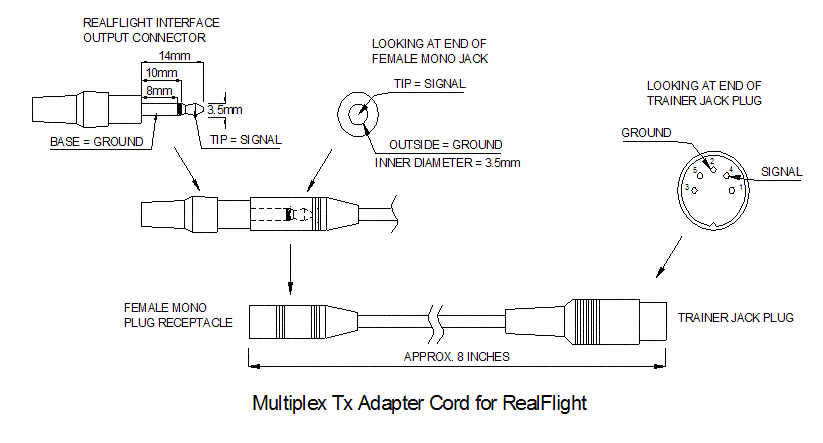
Controller
A game port to USB adapter is not available.
Please note: All RealFlight, R/C Pilot, and RealRace products that included a game port controller are discontinued and not supported for use with Windows Vista, 7, 8.x, or 10.
Summary
The following explains how to change a Mode 2 RealFlight Controller to Mode 1.
Resolution
Please read all instructions carefully before you begin this conversion. Horizon Hobby will not accept responsibility for incidental damage to your flight controller or personal computer. Please contact Product Support prior to performing this conversion if you have any questions about this procedure.
Tools Needed
- Medium phillips-head screwdriver
- Hemostats (preferred), or needle-nose pliers
Instructions
- Make sure your RealFlight controller is completely disconnected from your computer. Failure to do so could result in permanent damage to your controller and/or your computer.
- Remove the four screws from the rear of the controller, remove the rear half of the case, and lay the controller face-down on your workspace.
- Remove the silver metal ratchet lever and screw from the gimbal on the right-hand side. This is the throttle ratchet. Physically relocate it to the gimbal on the left-hand side. Rotate the metal ratchet 180 degrees, so the screw hole is now nearest the switch on the top left side of the controller, and the ratchet end is now pointing downward and resting on the ribbed surface of the gimbal. Line up the lever's hole over the plastic mounting stud on the gimbal, insert the screw and tighten to a snug fit (making sure the lever maintains proper alignment over the ribbed area of the gimbal). DO NOT OVER TIGHTEN, as the plastic gimbal may easily become stripped.
- On the left-hand gimbal, notice there is an arm-and-spring type lever mounted vertically along the inner-right side of the gimbal, the spring attached at the lower end to a plastic mounting stud which is held in place with a small brass screw. This arm / spring / stud assembly must now be moved to the right-hand gimbal. Using pliers, gently pry the head of the spring upwards off of the plastic mounting stud. Simply pull the mounting stud with screw out of the gimbal and set aside. Now remove the spring and arm from the gimbal (this may require slight maneuvering of the parts to get them out from behind the main body of the gimbal). NOTE: The arm is held in place by its two pivot lugs near the top of the gimbal, which rest inside mounting flanges on the main body of the gimbal. Simply lift the arm near the lugs. It should easily slide out of the flanges and be removed completely.
- Looking at the gimbal on the right-hand side, on the inner-left side near the bottom, notice similar arm mounting flanges as seen on the other gimbal. Take the arm just removed from the other gimbal, insert the lever end into the space located just above these mounting flanges, and rotate the arm upward until the arm's lugs can rotate downward and rest into the flanges. Notice the opposite end of the lever can now be seen near the top end of the gimbal. Take the spring which was removed from the other gimbal and, using hemostats, grab one end of the spring (lock the hemostats for best results). Now, holding the spring with the hemostats, insert the spring down into the gimbal so the loop on the opposite end hooks onto the end of the arm. Once hooked, take the mounting stud and screw (which was removed from the other gimbal) and insert it into the mounting flange on the top end of the right gimbal (do not use screwdriver), making sure the small arm is pointing towards the bottom end of the controller. Once the mounting stud is in in place, use the hemostat to pull the end of the spring upwards and hook it onto the small arm of the mounting flange, and release the hemostat. If any question arises to the assembly of the arm / spring / stud mechanism, refer to the arm already in place on the bottom of either gimbal, as they are assembled in the same manner.
- Both gimbals are now in the Mode 1 configuration. No alteration of any wires is necessary. Simply enter the RealFlight program and configure the software to operate in the Mode 1 setting.
Resolution
RealFlight, RealFlight Deluxe, RealRace or R/C Pilot
- Access the Controller screen. To do so, click on the Simulator Settings button.
- Click on the Calibrate button and follow the onscreen instructions to calibrate the controller accordingly.
- Test the simulation once again. Did this resolve the difficulty? If the previous steps have solved the difficulty it is unnecessary to proceed any further. If not, please proceed to step 4.
- Completely Exit the simulation and return to the main Windows menu.
- Click the Start button.
- Select the Settings options and then click the Control Panel.
- In the Control Panel, click on the Gaming Options.
- Click on the Advanced tab and then click on the Poll with interrupts enabled dialog box in the lower left corner.
- Click OK to exit the Gaming Options selections.
- Return to the main Windows menu, and start the simulator once again.
RealFlight Generation 2
- Access the Controller screen. To do so, click on the Options menu and then the Calibrate Controller menu.
- Click on the Calibrate button. Follow the onscreen instructions to calibrate the controller accordingly.
- Test the simulator once again. Did this resolve the difficulty? If the previous steps have solved the difficulty it is unnecessary to proceed any further. If not, please proceed to step 4.
- Completely Exit the simulation and return to the main Windows menu.
- Click the Start button.
- Select the Settings options and then click the Control Panel.
- In the Control Panel, click on the Gaming Options.
- Click on the Advanced tab and then click on the Poll with interrupts enabled dialog box in the lower left corner.
- Click OK to exit the Gaming Options selections.
- Return to the main Windows menu, and start the simulator once again.
- Start the simulation once again.
Resolution
Batteries are not needed to operate the controller. The controller is made using the case from an actual Futaba transmitter, giving it a more realistic feel. The computer provides the power for the controller.
The RealFlight Game Port Controller does not require batteries. The battery door is there only to complete the look and feel of a real R/C transmitter.
InterLink
Answer
Unfortunately, the USB InterLink and InterLink Plus controllers will not work on Windows 95. The USB support provided by the Windows 95 Operating System does not contain the necessary drivers to support a USB device such as the InterLink. Therefore, you must have Windows 98, ME, 2000, or XP for the controller to work properly.
Resolution
Batteries are not needed to operate the USB InterLink Controller. The controller is made using the case from an actual Futaba transmitter, giving it a more realistic feel. The computer provides the power for the controller.
Resolution
The serial number for the USB InterLink Controller is located on the actual InterLink itself. Looking at the rear of the controller, you will find it on the smaller white label towards the bottom of the controller below the interface port.
Summary
The following is instruction to change a Mode 2 RealFlight InterLink Controller to Mode 1.
Resolution
Tools Needed
- Medium Phillips-head screwdriver
- Hemostats (preferred), or needle nose pliers
Instructions
Please read all instructions carefully before you begin this conversion. Horizon Hobby will not accept responsibility for incidental damage to your InterLink controller or personal computer as a result of failure to adhere to these instructions properly. Please contact RealFlight Support prior to performing this conversion if you have any questions about this procedure.
- Make sure your RealFlight InterLink Controller is completely disconnected from your computer. Failure to do so could result in permanent damage to your InterLink and/or your computer.
- Remove the four screws from the rear of the controller, remove the case rear half, and lay the controller face-down on your workspace.
- Remove the silver metal ratchet lever and screw from the gimbal on the right-hand side. This is the throttle ratchet. Physically relocate it to the gimbal on the left-hand side. Rotate the metal ratchet 180 degrees, so the screw hole is now nearest the switch on the top left side of the controller, and the ratchet end is now pointing downward and resting on the ribbed surface of the gimbal. Line up the lever's hole over the plastic mounting stud on the gimbal, insert the screw and tighten to a snug fit (making sure the lever maintains proper alignment over the ribbed area of the gimbal). DO NOT OVERTIGHTEN, as the plastic gimbal may become easily stripped.
- On the left-hand gimbal, notice there is an arm-and-spring type lever mounted vertically along the inner-right side of the gimbal, the spring attached at the lower end to a plastic mounting stud. This arm and spring assembly must now be moved to the right-hand gimbal. Using pliers, gently pry the head of the spring upwards off of the plastic arm. Now remove the spring and arm from the gimbal (this may require slight maneuvering of the parts to get them out from behind the main body of the gimbal). NOTE: Pivot the arm outward, then slide to the side to remove it from the gimbal.
- Looking at the right-hand gimbal from the back, on the inner-left side, notice similar arm and spring mounting lugs as were on the other gimbal, except the spring lug is now on the bottom end and the pivot arm lug is on the top end. Take the arm just removed from the other gimbal, insert the pivot end onto the round pivot lug on the upper inside part of this gimbal and rotate the arm downward over the gimbal. With pliers or hemostat, grab one end of the spring which was removed from the other gimbal. Insert the spring down into the gimbal so the loop on the opposite end hooks onto the plastic lug located on the inside bottom-end of the gimbal. Once hooked, gently pull the opposite end of the spring outward and loop it over the end of the plastic arm. If any question arises to the assembly of the arm and spring assembly, refer to the arm already in place on the bottom of the gimbal as they are assembled in the same manner.
- Both gimbals are now in the Mode 1 configuration. No alteration of any wires is necessary. Reinstall the rear of the case onto the front half and re-install the four case screws.
- Simply enter the RealFlight program and configure the software to operate in the Mode 1 setting. This is found in the Controller Calibration dialog in the Options menu. Change the Stick Mapping to Mode 1.
Summary
When using the RealFlight USB Interlink Controller, you receive an error message that says the USB Interlink Controller is not connected.
-OR-When using the RealFlight USB Interlink Controller, you receive an error message that says KEerror 3994 I-Controller does not appear in the Control Panel.
Resolution
- Make sure you have all the latest updates for your version of Windows. This is especially important if you have Windows 98 First Edition since full support for USB did not become available until Windows 98 Second Edition. You can access the Windows Update feature from your Start menu while you are connected to the Internet. For specific assistance with this feature please contact your computer manufacturer or Microsoft.
- Make sure you have all the latest updates for RealFlight itself. You can access the latest update for RealFlight by first making sure that RealFlight itself is not running, and then calling up the RealFlight Control Panel, making sure you are connected to the Internet through your ISP. On the RealFlight Control Panel, click on the Online Updates button. From the Online Updating dialog box, you will first need to register your copy of RealFlight before you update to the latest version. The product update is only available to registered owners of RealFlight.
- If you are using the USB Interlink Controller through any kind of an external USB hub, make sure the hub has a power supply as the USB Interlink Controller will not work otherwise.
- If you had the USB Interlink Controller plugged into your system before you installed RealFlight, then please try disconnecting the USB Interlink Controller and any other USB device from your PC and restart your system. Once Windows is completely rebooted, try plugging your USB Interlink Controller back into a USB port, making sure you plug the USB connection firmly into the USB port.
-
If Step 4 did not provide you with a successful
solution, then please try uninstalling and re-installing RealFlight,
making sure you DO NOT connect the USB Interlink Controller to your PC
until the software prompts you to do so (a message will appear on your
screen when the software is ready for you to plug the USB Interlink
Controller into a USB port). If you are using Norton Antivirus, Norton
Utilities, Norton System Works, or any other virus scan or system
protection/monitoring utility, please make sure that all those utilities
are completely disabled when you install, update, or run RealFlight as
those kinds of utilities can cause conflicts with other programs when
they are attempting to install, update, and/or run successfully.
- If you are still getting an error message that says the USB Interlink Controller is not connected or KEerror 3994 I-Controller does not appear in the Control Panel, then please close out of any open windows and dialog boxes that may be open at this time. Make sure the USB Interlink Controller is the only USB device connected to your PC at this time. IMPORTANT: make sure you have your Windows installation/recovery disk there with you in case Windows needs to install components for itself from the Windows disk during the following process.
-
Go to your Start menu and select Settings then Control
Panel.
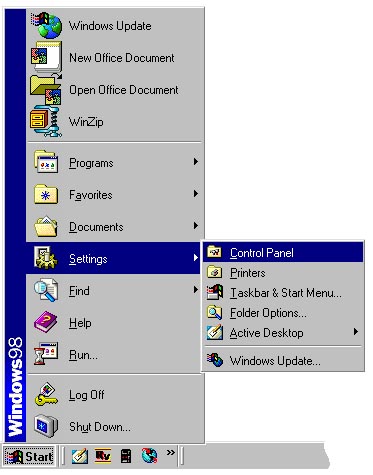
-
From the Windows Control Panel, select the Add New Hardware option.

- From the Add New Hardware Wizard, Click Next to continue.
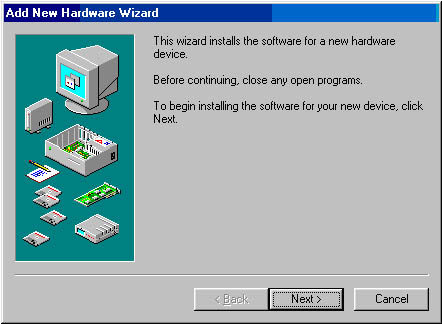
- Click Next to allow the Add New Hardware Wizard to search for all new Plug and Play devices on your PC.
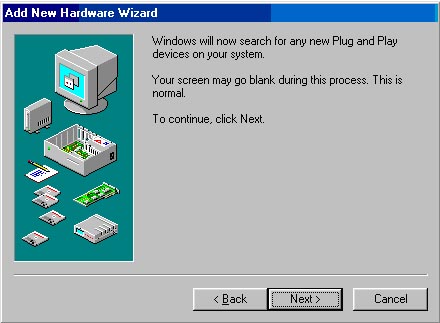
-
Windows is now searching for all Plug and Play devices on your PC. This process should take several seconds, so please allow
Windows to complete this process.
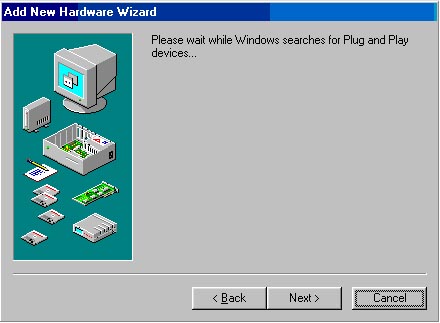
- Once Windows has detected all the available Plug and Play devices, you will need to tell Windows you are going to select the hardware from a list by selecting that option from the window shown below. Once you have made that selection, click Next to continue.
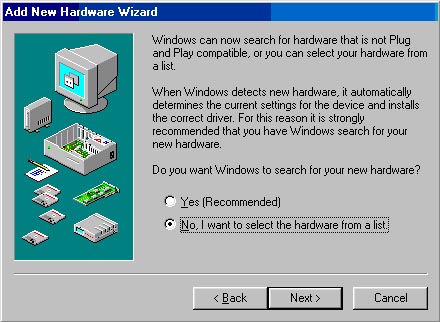
- From the Add New Hardware Wizard dialog box that asks you to select the type of hardware you want to install, select Human
Interface Devices and click Next to continue.
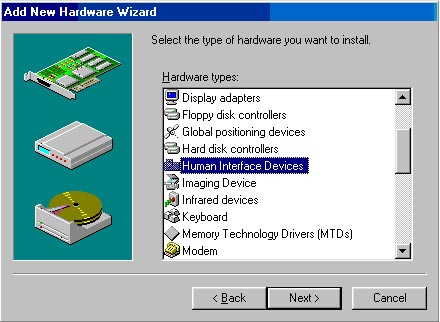
- Once Windows assembles the driver information database, the Add New Hardware Wizard will ask you to select the
manufacturer and model of the hardware you are adding. Make sure you have (Standard Device) selected for Manufacturers: and USB Human Interface Devices selected for Models: as shown and click Next to continue.
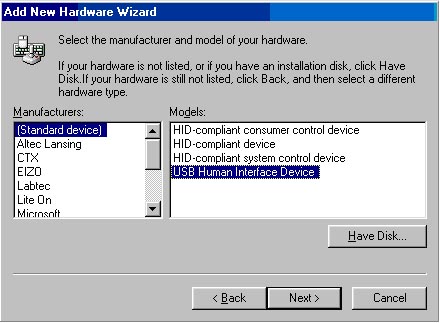
- You should next get the dialog box shown below. Click Next to install the software necessary to support the new device. If
Windows asks you for the Windows disk, insert the Windows disk and allow Windows to install any components it needs at this time.
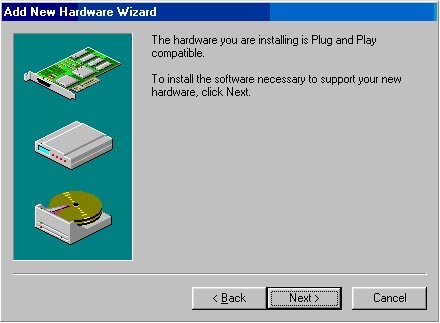
- The Add new Hardware Wizard should have finished installing the software necessary to support the new hardware device.
Click Finish to complete the process.
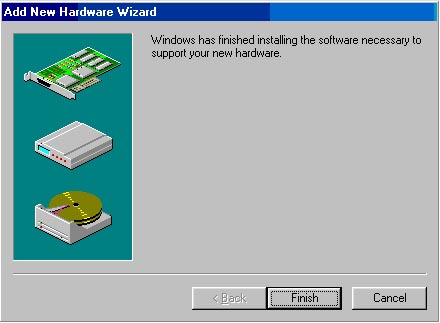
- Try running RealFlight again and see if the USB Interlink Controller is now functioning correctly. If you are still getting an error message related to the I-Controller not being connected or not appearing in the Control Panel, then please try contacting RealFlight Software Support for assistance.
Resolution
To take advantage of the 3-position switch, first download the latest version of RealFlight G2.
Programming a helicopter to take advantage of the three-position switch requires that you first make a copy of the respective heli. To do so, highlight the desired model and click on the 'Make a Copy' button. Follow the onscreen instructions and rename your model accordingly. Next, click the 'Edit' button.
This will bring up the screen below. In the 'Radio Type' dialog box, click the "Edit Now…" button.
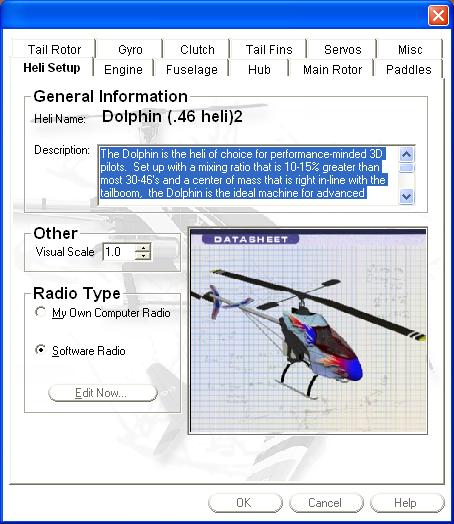
After clicking on the 'Edit Now…' button, the following window will appear. It is in this window that you will determine which switch, switch position, or key, etc. controls the various flight modes and so forth.
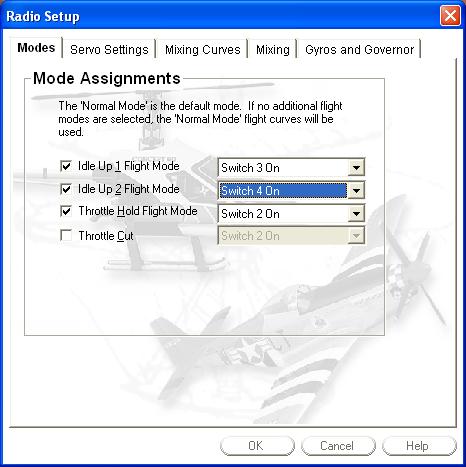
To adjust the switch, switch position, etc. click the indication box to the right of the respective Flight Mode. This will bring up the dropdown menu selections with the available options. For example, if you wish to set the "Idle Up 1 Flight Mode" click on the box to the right of 'Idle Up 1 Flight Mode'. To control the 'Idle Up 1 Flight Mode' using the 3-Position switch at the middle position, set it to "Switch 3 On" or "3 Pos Mid." Both options appear in the dropdown menu and have the same effect on the program.
Additionally, if you wish to use the down, or closest switch position towards you for the "Idle Up 2 Flight Mode", simply click in the appropriate box and alter the switch to either "Switch 4 On" or "3 Pos Down" as indicated in the following screens.
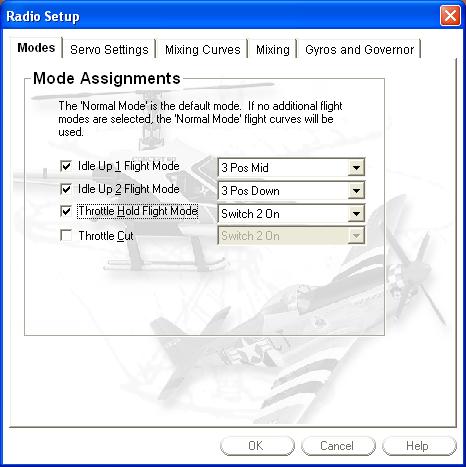
The reason that Switch 3 and 4 are still an option in the dropdown menus is to allow for the backwards compatibility with aircraft that have been customized with previous versions of the RealFlight software. It is suggested that you use the 3 Pos up, mid, down with the InterLink to guarantee that it will work with future versions of RealFlight.
Summary
The following is instruction to change a Mode 1 RealFlight InterLink Controller to Mode 2.
Resolution
Tools Needed
- Medium Phillips-head screwdriver
- Hemostats (preferred), or needle nose pliers
Instructions
Please read all instructions carefully before you begin this conversion. Horizon Hobby will not accept responsibility for incidental damage to your InterLink controller or personal computer as a result of failure to adhere to these instructions properly. Please contact RealFlight Support prior to performing this conversion if you have any questions about this procedure.
- Make sure your RealFlight InterLink Controller is completely disconnected from your computer. Failure to do so could result in permanent damage to your InterLink and/or your computer.
- Remove the four screws from the rear of the controller, remove the case rear half, and lay the controller face-down on your workspace.
- Remove the silver metal ratchet lever and screw from the gimbal on the left-hand side. This is the throttle ratchet. Physically relocate it to the gimbal on the right-hand side. Rotate the metal ratchet 180 degrees, so the screw hole is now on the bottom right side of the gimbal, and the ratchet end is now pointing upward nearest the switch on the top right side, and resting on the ribbed surface of the gimbal. Line up the lever's hole over the plastic mounting stud on the gimbal, insert the screw and tighten to a snug fit (making sure the lever maintains proper alignment over the ribbed area of the gimbal). DO NOT OVERTIGHTEN, as the plastic gimbal may become easily stripped
- On the right-hand gimbal, notice there is an arm-and-spring type lever mounted vertically along the inner-left side of the gimbal, the spring attached at the lower end to a plastic mounting stud. This arm and spring assembly must now be moved to the left-hand gimbal. Using pliers, gently pry the head of the spring upwards off of the plastic arm. Now remove the spring and arm from the gimbal (this may require slight maneuvering of the parts to get them out from behind the main body of the gimbal). NOTE: Pivot the arm outward, then slide to the side to remove it from the gimbal.
- Looking at the left-hand gimbal from the back, on the inner-right side, notice similar arm and spring mounting lugs as were on the other gimbal, except the spring lug is now on the top end and the pivot arm lug is on the bottom end. Take the arm just removed from the other gimbal, insert the pivot end onto the round pivot lug on the lower inside part of this gimbal and rotate the arm upward over the gimbal. With pliers or hemostat, grab one end of the spring which was removed from the other gimbal. Insert the spring down into the gimbal so the loop on the opposite end hooks onto the plastic lug located on the inside top-end of the gimbal. Once hooked, gently pull the opposite end of the spring outward and loop it over the end of the plastic arm. If any question arises to the assembly of the arm and spring assembly, refer to the arm already in place on the bottom of the gimbal as they are assembled in the same manner.
- Both gimbals are now in the Mode 2 configuration. No alteration of any wires is necessary. Reinstall the rear of the case onto the front half and re-install the four case screws.
- Simply enter the RealFlight program and check the configuration of the software to operate in the Mode 2 setting. This is found in the Controller Calibration dialog in the Options menu. No change to the Stick Mapping should be necessary to Mode 2.
Summary
The following is a description for how to assemble an adapter cord to connect a Multiplex transmitter with the parallel port transmitter interface and the InterLink controller for RealFlight. For all instructions, reference the diagram below.
Resolution
Necessary Components
- One 5-pin round male connector compatible with Multiplex transmitter trainer jacks. This should be very similar in style to the plug used on Multiplex trainer cords.
- One female mono plug receptacle, compatible with the dimensions shown for the "RealFlight Interface Output Connector" as shown in the diagram. NOTE: it is important that the female receptacle has an inner diameter of 3.5mm, a depth of 14mm at the tip, and a depth no greater than 8mm for the base.
- Adequate wiring to connect both jacks together. Wire should be copper, having a high strand count. Do not use single strand wire. Two conductors will be required; one conductor for signal connections, one conductor for ground connections.
- Large and small shrink tubing
- Wire strippers
- 60/40 rosin-core electrical solder
- A 40-watt soldering iron
Assembly Instructions
- Cut each conductor to approximately 8 inches in length.
- Strip approximately 1/4 inch of insulation away from each end of each conductor. Twist the bare strands of wire tightly on each wire end.
- Cut enough pieces of shrink tubing to completely cover each solder connection. Make sure to slide the tubes over the wire ends BEFORE making solder connections.
- "Tin" each end of bare wire with 60/40 rosin-core solder and a hot soldering iron. This is simply to apply a small amount of solder onto the bare wire end to prepare it for soldering onto the jacks.
- "Signal" connection:
- Solder one end of the signal wire to pin #4 on the "trainer jack plug". IMPORTANT: this is the pin located at the 2 o'clock position when looking at the end of the plug itself, as shown in the diagram.
- Solder the other end of the signal wire to the center connection on the "female mono plug receptacle".
- "Ground" connection:
- Solder one end of the ground wire to pin #2 on the "trainer jack plug". IMPORTANT: this is the pin located at the 12 o'clock position when looking at the end of the plug itself, as shown in the diagram.
- Solder the other end of the ground wire to the outside connection on the "female mono plug receptacle".
- Slide all shrink tubes over their respective connections. Apply heat with a heat gun or hair dryer to shrink the tubing over the entire solder connection. This will provide a good electrical insulator for the solder connections, and a good strain relief for the physical connection.

The InterLink Controller does not require batteries. The battery door is there only to complete the look and feel of a real R/C transmitter.
Multiplayer
Answer
If you are having connection problems using the Multiplayer features, you should see if the problem occurs with the basic Multiplayer and Network functionality. To do this, you can run Chatpeer, a program written by Microsoft which is designed to test the basic Multiplayer functionality. If you see the same problems with Chatpeer, you should assume the problem is with your network connection.
To run Chatpeer:
- Start the RealFlight Control Panel (Start Menu/Programs/RealFlight) - or RealRace
- Click on the Technical Support button
- Click on the Chatpeerbutton
- Have another person who you are trying to connect with do the same steps
- One person needs to "Create" the chat, and the other person will join it.
If Chatpeer works, and you are still having problems with G2's Multiplayer feature, please contact Product Support.
Compatibility
As with a desktop PC, you must ensure your laptop meets or exceeds all the System Requirements for the version of RealFlight you intend to use. Since RealFlight is 3D accelerated, it is especially important that the display device on your laptop is designed to support graphics-intensive 3D games. Laptops intended for 3D gaming will be built with a video card rather than an integrated graphics processor. Gaming-capable laptops are typically marketed as "gaming laptops" or "multimedia laptops".
For more information regarding the expected performance of your laptop, please contact your laptop manufacturer.
RealFlight is compatible only with Microsoft Windows and cannot be used with Mac OS/OSX operating systems. But if you can run Windows on your Macintosh computer, you should also be able to run RealFlight.
Apple now offers a program called "Boot Camp" that does allow Macintosh users to dual-boot Windows with Mac OS/OSX. For help installing Windows onto your Mac using Boot Camp, contact Apple Support.
An integrated graphics processor is a low power substitute for a video card and is not intended for resource intensive 3D games. Integrated graphics use shared system memory (RAM) for video memory and the central processor (CPU) for graphics processing. A video card has the dedicated video memory (VRAM) and graphics processor (GPU) needed for handling 3D games.
For more information regarding the expected performance of the display device on your laptop or desktop computer, please contact your system manufacturer.
| EP 1 | EP 2 | EP 3 | EP 4 | EP 5 | EP 6 | EP 7 | EP 8 | |
|---|---|---|---|---|---|---|---|---|
| RealFlight Classic | N | N | N | N | N | N | N | N |
| RealFlight Deluxe | N | N | N | N | N | N | N | N |
| R/C Pilot | N | N | N | N | N | N | N | N |
| RealFlight G2 | N | N | N | N | N | N | N | N |
| RealFlight G2 Lite | N | N | N | N | N | N | N | N |
| RealFlight NexSTAR | N | N | N | N | N | N | N | N |
| RealFlight NexSTAR EP | N | N | N | N | N | N | N | N |
| RealFlight G3.x | C | C | C | C | N | N | N | N |
| RealFlight G4.x | C | C | C | C | C | C | N | N |
| RealFlight Basic | N | N | N | N | N | N | N | N |
| RealFlight G5.x | C | C | C | C | C | C | C | C |
| RealFlight 6.x | C | C | C | C | C | C | C | C |
| RealFlight 7.x | C | C | C | C | C | C | C | C |
| RealFlight 8.x | C | C | C | C | C | C | C | C |
| RealFlight 9.x | C | C | C | C | C | C | C | C |
| RealFlight Drone | N | N | N | N | N | N | N | N |
| RF-X | N | N | N | N | N | N | N | N |
The Expansion Packs are not interdependent. They can be installed in any order or combination into a compatible version of RealFlight.
| AOV 1 | AOV 2 | AOV 3 | AOV 4 | AOV 5 | |
|---|---|---|---|---|---|
| RealFlight Classic | C | C | C | C | N |
| RealFlight Deluxe | C | C | C | C | N |
| R/C Pilot | N | N | N | N | N |
| RealFlight G2 | C | C | C | C | C |
| RealFlight G2 Lite | C | C | C | C | C |
| RealFlight NexSTAR | N | N | N | N | N |
| RealFlight NexSTAR EP | N | N | N | N | N |
| RealFlight G3.x | C | C | C | C | C |
| RealFlight G4.x | N | N | N | N | N |
| RealFlight Basic | N | N | N | N | N |
| RealFlight G5.x | N | N | N | N | N |
| RealFlight 6.x | N | N | N | N | N |
| RealFlight 7.x | N | N | N | N | N |
| RealFlight 8.x | N | N | N | N | N |
| RealFlight 9.x | N | N | N | N | N |
| RealFlight Drone | N | N | N | N | N |
| RF-X | N | N | N | N | N |
The Add-Ons Volume disks are not interdependent. They can be installed in any order or combination into a compatible version of RealFlight.
Please Note: The aircraft and airports from Add-Ons Volumes 1-5 were re-developed for compatibility with RealFlight G4.x, G5.x, 6.x, 7.x, and 8.x. That content is now available as a free download.
| Airplane Mega Pack | |
|---|---|
| RealFlight Classic | N |
| RealFlight Deluxe | N |
| R/C Pilot | N |
| RealFlight G2 | N |
| RealFlight G2 Lite | N |
| RealFlight NexSTAR | N |
| RealFlight NexSTAR EP | N |
| RealFlight G3.x | N |
| RealFlight G4.x | N |
| RealFlight Basic | N |
| RealFlight G5.x | N |
| RealFlight 6.x | C |
| RealFlight 7.x | C |
| RealFlight 8.x | C |
| RealFlight 9.x | C |
| RealFlight Drone | N |
| RF-X | N |
| Helicopter Mega Pack | |
|---|---|
| RealFlight Classic | N |
| RealFlight Deluxe | N |
| R/C Pilot | N |
| RealFlight G2 | N |
| RealFlight G2 Lite | N |
| RealFlight NexSTAR | N |
| RealFlight NexSTAR EP | N |
| RealFlight G3.x | N |
| RealFlight G4.x | N |
| RealFlight Basic | N |
| RealFlight G5.x | N |
| RealFlight 6.x | C |
| RealFlight 7.x | C |
| RealFlight 8.x | C |
| RealFlight 9.x | C |
| RealFlight Drone | N |
| RF-X | N |
| InterLink Controller | |
|---|---|
| RealFlight Classic | N |
| RealFlight Deluxe | N |
| R/C Pilot | N |
| RealFlight G2 | C |
| RealFlight G2 Lite | C |
| RealFlight NexSTAR | N |
| RealFlight NexSTAR EP | N |
| RealFlight G3.x | N |
| RealFlight G4.x | N |
| RealFlight Basic | N |
| RealFlight G5.x | N |
| RealFlight 6.x | N |
| RealFlight 7.x | N |
| RealFlight 8.x | N |
| RealFlight 9.x | N |
| RealFlight Drone | N |
| RF-X | N |
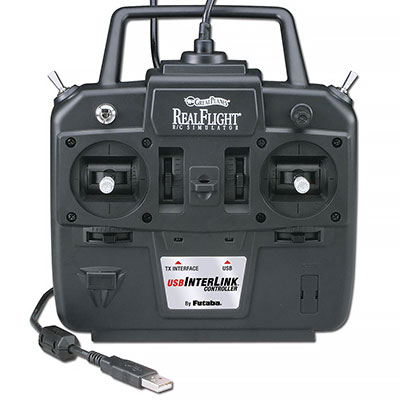
| Printer Port Transmitter Interface | |
|---|---|
| RealFlight Classic | C |
| RealFlight Deluxe | C |
| R/C Pilot | N |
| RealFlight G2 | C |
| RealFlight G2 Lite | N |
| RealFlight NexSTAR | N |
| RealFlight NexSTAR EP | N |
| RealFlight G3.x | N |
| RealFlight G4.x | N |
| RealFlight Basic | N |
| RealFlight G5.x | N |
| RealFlight 6.x | N |
| RealFlight 7.x | N |
| RealFlight 8.x | N |
| RealFlight 9.x | N |
| RealFlight Drone | N |
| RF-X | N |
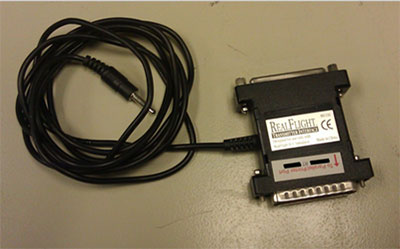
| RealFlight Game Port Controller | |
|---|---|
| RealFlight Classic | C |
| RealFlight Deluxe | C |
| R/C Pilot | N |
| RealFlight G2 | C |
| RealFlight G2 Lite | N |
| RealFlight NexSTAR | N |
| RealFlight NexSTAR EP | N |
| RealFlight G3.x | N |
| RealFlight G4.x | N |
| RealFlight Basic | N |
| RealFlight G5.x | N |
| RealFlight 6.x | N |
| RealFlight 7.x | N |
| RealFlight 8.x | N |
| RealFlight 9.x | N |
| RealFlight Drone | N |
| RF-X | N |
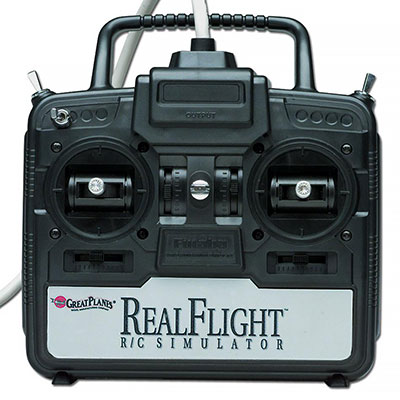
HowTo
Summary
Improve overall performance in RealFlight.
Resolution
During installation, RealFlight analyzes your computer's hardware specifications. RealFlight then tries to optimize its configuration to best take advantage of that hardware, and achieve the best possible performance.
However, if the performance is less than you'd expect, you can adjust some of RealFlight's settings to improve the simulation speed and frame rate:
- Ensure that the drivers for the video and sound cards are up-to-date.
- Turn off all other programs, especially virus checkers and network applications (such as Instant Messengers) while running RealFlight. Use CTRL-ALT-DELETE to ensure that nothing else is running in the background.
- Run the simulation in Full Screen Mode (in the Options menu, uncheck the Run in Window option).
- Alternatively, if you are running in Window Mode (Run in Window option is checked), alter the screen resolution from 32-bit to 16-bit color. Also, decrease the size of the RealFlight window.
- Reduce the texture quality. This can have a profound effect on cards that do not have a high texture memory. You can adjust texture quality on the Graphics Optimization page. To do so, click on the Options menu and then access the Graphics Optimizations menu.
- Use Photofield rather than the 3D Terrain option. In the Airport menu, uncheck the 3D Terrains item (if the item is not checked, you are already using Photofield). Or, if you don't want to use Photofield, decrease the terrain density using the Graphics Optimizations page.
- Eliminate the Airport Objects Shadow using the Graphics Optimizations page.
- Eliminate the Detail Textures using the Graphics Optimizations page.
- Reduce the number of open Gadgets. Click the "X" on each Gadget that you wish to close.
- Eliminate the Smoke/Exhaust options. Press ` (the accent key) on the keyboard.
- Disable the trees. In the Airport menu, uncheck the Show Trees option (this will make all trees and foliage disappear from your flying field).
- Reduce the number of recordings that are currently in use.
- Eliminate collisions. Uncheck Enable Collisions in the Options menu. (If the Enable Collisions item is not checked, collisions were not previously active.)
- It may be necessary to increase the System RAM of your PC. Click on the Windows Start menu, select Program Files/RealFlight/ RealFlight Control Panel. Next, click on the Technical Support button. The system RAM will be displayed on the third line. If you have 64MB or less, you may wish to add more RAM to this system.
Summary
The following explains how to change a Mode 2 RealFlight Controller to Mode 1.
Resolution
Please read all instructions carefully before you begin this conversion. Horizon Hobby will not accept responsibility for incidental damage to your flight controller or personal computer. Please contact Product Support prior to performing this conversion if you have any questions about this procedure.
Tools Needed
- Medium phillips-head screwdriver
- Hemostats (preferred), or needle-nose pliers
Instructions
- Make sure your RealFlight controller is completely disconnected from your computer. Failure to do so could result in permanent damage to your controller and/or your computer.
- Remove the four screws from the rear of the controller, remove the rear half of the case, and lay the controller face-down on your workspace.
- Remove the silver metal ratchet lever and screw from the gimbal on the right-hand side. This is the throttle ratchet. Physically relocate it to the gimbal on the left-hand side. Rotate the metal ratchet 180 degrees, so the screw hole is now nearest the switch on the top left side of the controller, and the ratchet end is now pointing downward and resting on the ribbed surface of the gimbal. Line up the lever's hole over the plastic mounting stud on the gimbal, insert the screw and tighten to a snug fit (making sure the lever maintains proper alignment over the ribbed area of the gimbal). DO NOT OVER TIGHTEN, as the plastic gimbal may easily become stripped.
- On the left-hand gimbal, notice there is an arm-and-spring type lever mounted vertically along the inner-right side of the gimbal, the spring attached at the lower end to a plastic mounting stud which is held in place with a small brass screw. This arm / spring / stud assembly must now be moved to the right-hand gimbal. Using pliers, gently pry the head of the spring upwards off of the plastic mounting stud. Simply pull the mounting stud with screw out of the gimbal and set aside. Now remove the spring and arm from the gimbal (this may require slight maneuvering of the parts to get them out from behind the main body of the gimbal). NOTE: The arm is held in place by its two pivot lugs near the top of the gimbal, which rest inside mounting flanges on the main body of the gimbal. Simply lift the arm near the lugs. It should easily slide out of the flanges and be removed completely.
- Looking at the gimbal on the right-hand side, on the inner-left side near the bottom, notice similar arm mounting flanges as seen on the other gimbal. Take the arm just removed from the other gimbal, insert the lever end into the space located just above these mounting flanges, and rotate the arm upward until the arm's lugs can rotate downward and rest into the flanges. Notice the opposite end of the lever can now be seen near the top end of the gimbal. Take the spring which was removed from the other gimbal and, using hemostats, grab one end of the spring (lock the hemostats for best results). Now, holding the spring with the hemostats, insert the spring down into the gimbal so the loop on the opposite end hooks onto the end of the arm. Once hooked, take the mounting stud and screw (which was removed from the other gimbal) and insert it into the mounting flange on the top end of the right gimbal (do not use screwdriver), making sure the small arm is pointing towards the bottom end of the controller. Once the mounting stud is in in place, use the hemostat to pull the end of the spring upwards and hook it onto the small arm of the mounting flange, and release the hemostat. If any question arises to the assembly of the arm / spring / stud mechanism, refer to the arm already in place on the bottom of either gimbal, as they are assembled in the same manner.
- Both gimbals are now in the Mode 1 configuration. No alteration of any wires is necessary. Simply enter the RealFlight program and configure the software to operate in the Mode 1 setting.
Summary
Windows Explorer is one key application with which you should familiarize yourself. This article will briefly describe how to use Windows Explorer. If you are new to the Windows Operating system or to computers in general, it is strongly suggested that you purchase a 'How to' book at your local bookstore. This material will more than likely explain the software in greater detail.
What is Windows Explorer?
Windows Explorer offers you a fast, easy way to view, copy, delete, move, etc., the folders and files found on all of your disk drives. Think of it as one really big filing cabinet. It is important to note that the Windows Explorer application is different from Internet Explorer. Windows Explorer lets you play with the files on your computer, while Internet Explorer allows you to connect to other computers via the World Wide Web.
How to open Windows Explorer
For Windows 95, 98, and ME:
- Click the Windows Start button, and then select the Programs button.
-
Click on Windows Explorer.
For Windows 2000 and XP:
-
Click the Windows Start button, and then select the Programs button.
-
Select the Accessories button.
-
Click on Windows Explorer.
For Windows Vista and 7:
-
Click the Windows logo in the task bar at the lower left.
-
Click Computer from the menu that appears.
What are Drives, Folders and Files?
For organizational purposes, everything on your computer is reduced or segmented into very specific parts and locations. Your PC also consists of drives which are further broken down into Hard Drive(s), CD-ROM drives, floppy drives, ZIP drives (if applicable) and so forth. Within each Drive, there are hundreds, and potentially thousands of Folders and Files. Again, each of these files and folders are of great assistance in keeping things orderly.
A Folder is very similar to a folder in a file cabinet. Inside each of the Folders, there may very well be more sub-folders, or Files. Folders are a great way to keep you organized on different projects that you may be involved with. For example, you might have a Folder for all of your documents, and another for all of your spreadsheets. Furthermore, you may have sub-folders within these to keep those documents even more organized.
Each individual document and spreadsheet within is known as a File. Files are the items that you are able to view and to work on if desired. Examples include images you download from your digital camera, or Word documents you've created.
What's inside all these folders?
When you open Windows Explorer, you will see two sections, a left 'pane' and right 'pane'. The left pane shows you your drives and folders. This layout is called a tree, as it closely resembles a tree with all of the 'branches'. To the left of each of the drives is a small [+] symbol. Using the mouse and clicking on this symbol will show you all the folders that are stored on that particular drive. Some of these folders themselves will also have a [+] symbol next to them. Again, this means that there are more sub-folders contained within that particular folder. If you click on the [+], it will open the folder list to reveal the contents and change the [+] to a minus [-] symbol. This simply means that the folder has been opened accordingly. If you click the [-] then it will close the folder and return it to the [+] symbol.
The right pane shows all the files and sub-folders that are contained within the folder that you are currently viewing with Explorer. For example, let's view the contents of the My Documents folder. Generally speaking, this folder is contained on the 'C:' drive of your PC. As such, locate your 'C:' drive in the left pane, click the [+] next to this drive- remember, if it's already opened, it will have a [-] next to it. From the folders listed in the 'C:' drive, locate the My Documents folder. Click on the Folder itself, not the [+] symbol next to it. This will change the contents of the right pane to display all of the sub-folders and files in My Documents.
Opening a file
It is important to note that your computer contains two vastly different types of files. There are Program files and Data files. Program files are the applications that you run on your computer. Examples of Program files include RealFlight and Windows Explorer itself. Data files, on the other hand, contain information that was created by the Program files. These might include text documents, photos or images and music. To open a Program file, simply point the mouse cursor on the file, and click twice (double-click) with the left mouse button. As an example we'll open RealFlight using Windows Explorer:
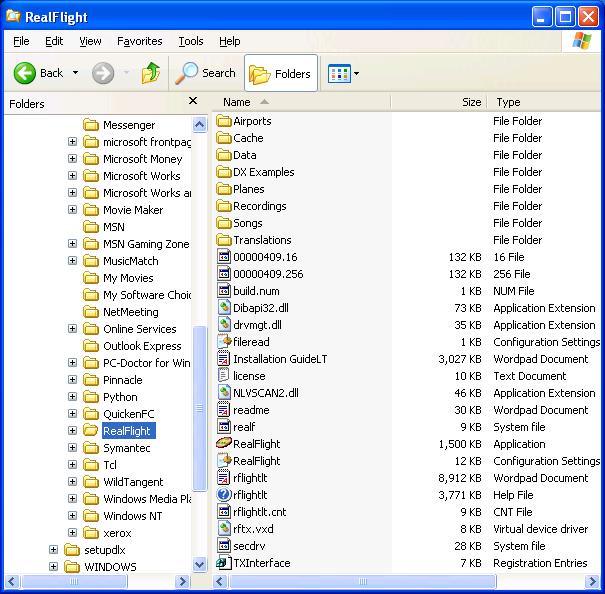
On the left pane, locate the hard drive that contains the RealFlight program. Generally, this is the 'C:' drive. Click the [+] symbol next to this drive. Again, if it shows the [-] symbol there is no need to click on it as the drive is open.
On the left pane below your hard drive, search for a folder labeled Program Files and click the [+] next to it. This will reveal the contents of the Program Files. Looking at the left pane below the Program Files listing locate a folder that has been designated as RealFlight. To open the RealFlight files, simply click the folder to access its contents. There is no need to click the [+]. The right pane will now display everything that is located in the RealFlight folder. Look for a file titled RealFlight that includes the same icon as the one that appears on your desktop. If you wish to start the RealFlight software, double-click this folder.
Data files are opened in exactly the same way. The only difference is that Windows will first open the application that is needed to view the data file. That is, you do not need to do this yourself. Again using RealFlight as an example, let's open the readme file that appears in the RealFlight folder.
Move or Copy a File
The simplest and most efficient way to move or copy a file is to use your mouse to drag it to the desired location. Moving a file is defined as taking the file out of one folder and placing it into a different folder. Copying, on the other hand, keeps the original file in its current or existing folder and makes an additional 'copy' in the new or target folder.
To move a file:
Locate the file you wish to move on the right pane.
Scroll the left pane so that the target folder or desired location appears. In other words, you are able to see the folder in which you wish to move the file. Click and hold down the left mouse button on the file you wish to move. With the mouse button still held down, move the mouse cursor to the target folder. While you are doing so, a faint image of the icon should now appear with the mouse cursor. When the target folder is highlighted, release the mouse button. This will move the file from its current location to the new desired location. Holding down the mouse button while moving the cursor is called 'dragging the mouse'.
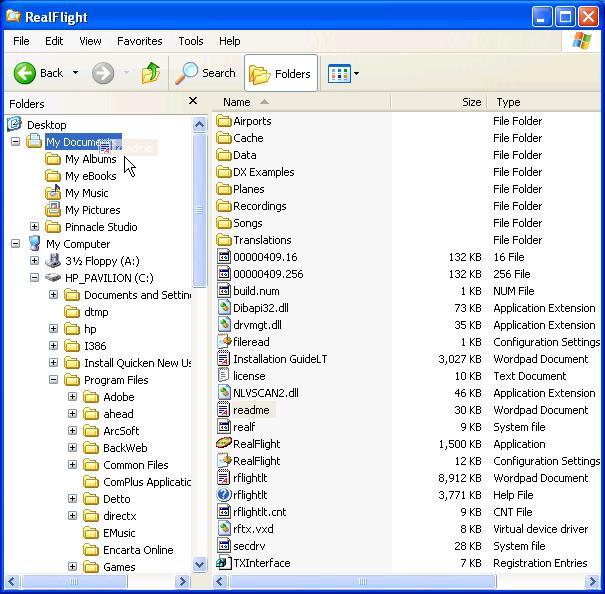
The file you moved should now appear in the new folder.
To copy a file:
To copy a file, follow the same steps as above for moving a file, but this time, hold down the Ctrl key on the keyboard while you are dragging the file.
The same steps can also be used for copying and moving folders themselves. When you copy or move a folder, everything in the folder, including files and sub-folders, are also transferred as well.
This article only briefly discusses what you can do with Windows Explorer. There are many, many additional features and functions offered by this application. If you are new to computers, or to Windows, or if you would simply like to investigate the functionality of this program, it is highly recommended that you check out your local bookstore for more reference.
Creating a new Folder
On the Menu bar, click File, then select New and finally click Folder and the folder will be created in the right hand pane. At this point, the new folder will be created and the name will be highlighted. Type in the name you wish to call the new folder. Make sure prior to making the new folder that you are located at the proper place in the hierarchical view in the left pane. The new folder will always be created as a subfolder of whatever location you have selected.

Drivers are the software installed to support the hardware on your computer (e.g. video card or sound card). The drivers for your computer are not supported through Horizon Hobby.
If you need to update a driver for your computer, please contact your computer manufacturer’s technical support.
Resolution
- Start the RealFlight Control Panel (or RealRace or R/C Pilot) by going to the Start Menu/Program/RealFlight menu.
- Click on RealFlight Control Panel
- Click on Technical Support
- Look at the text in the lower left
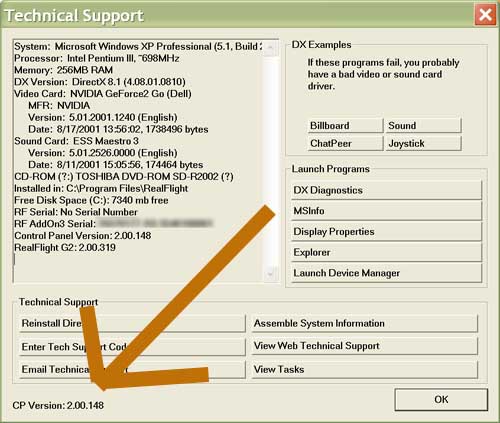
Answer
If you are having connection problems using the Multiplayer features, you should see if the problem occurs with the basic Multiplayer and Network functionality. To do this, you can run Chatpeer, a program written by Microsoft which is designed to test the basic Multiplayer functionality. If you see the same problems with Chatpeer, you should assume the problem is with your network connection.
To run Chatpeer:
- Start the RealFlight Control Panel (Start Menu/Programs/RealFlight) - or RealRace
- Click on the Technical Support button
- Click on the Chatpeerbutton
- Have another person who you are trying to connect with do the same steps
- One person needs to "Create" the chat, and the other person will join it.
If Chatpeer works, and you are still having problems with G2's Multiplayer feature, please contact Product Support.
The software version or 'build' will appear as: x.xx.xxx; 2.00.240 is one such example. There are several methods which may be utilized to determine the software version (or build) that you are running. The method utilized depends upon which software you are running as well as personal preference.
For RealFlight G3, G4, G5 and 6, double click the RealFlight Launcher on the desktop. The version number may be found at the top right hand corner of the Launcher screen.
For RealFlight G2 or RealRace G2, access the RealFlight Control Panel (or RealRace Control Panel). To do so, click on the Windows Start menu and select Program/RealFlight/RealFlight Control Panel. The version number may be found at the top of the Control Panel.
Alternately, run your RealFlight, R/C Pilot or RealRace software and click on the Help menu. Select About. The version number will be located approximately half-way down on the About screen.
Answer
If you are having video problems using RealFlight G2 or RealRace G2, you should see if the problem occurs with the basic Video Card functionality. To do this, you can run Billboard, a program written by Microsoft which is designed to test the basic Video Card functionality. If you see the same problems with Billboard, you should assume the problem is with your video card driver, video card, or other computer conflict.
To run Billboard:
- Start the RealFlight Control Panel (Start Menu/Programs/RealFlight) - (or RealRace)
- Click on the Technical Support button
- Click on the Billboard button
- Maximize the Billboard application to match the characteristics of the simulator.
- Also try to switch Billboard into Full Screen mode and make sure that works as well.
Answer
If you are having sound problems using RealFlight G2 or RealRace G2, you should see if the problem occurs with the basic Sound Card functionality. To do this, you can run Play3DSound, a program written by Microsoft which is designed to test the basic Sound Card functionality. If you see the same problems with Play3DSound, you should assume the problem is with your sound card driver, sound card, or other computer conflict.
To run Play3DSound:
- Start the RealFlight Control Panel (Start Menu/Programs/RealFlight) - (Or RealRace)
- Click on the Technical Support button
- Click on the Sound button
Summary
The following is instruction to change a Mode 2 RealFlight InterLink Controller to Mode 1.
Resolution
Tools Needed
- Medium Phillips-head screwdriver
- Hemostats (preferred), or needle nose pliers
Instructions
Please read all instructions carefully before you begin this conversion. Horizon Hobby will not accept responsibility for incidental damage to your InterLink controller or personal computer as a result of failure to adhere to these instructions properly. Please contact RealFlight Support prior to performing this conversion if you have any questions about this procedure.
- Make sure your RealFlight InterLink Controller is completely disconnected from your computer. Failure to do so could result in permanent damage to your InterLink and/or your computer.
- Remove the four screws from the rear of the controller, remove the case rear half, and lay the controller face-down on your workspace.
- Remove the silver metal ratchet lever and screw from the gimbal on the right-hand side. This is the throttle ratchet. Physically relocate it to the gimbal on the left-hand side. Rotate the metal ratchet 180 degrees, so the screw hole is now nearest the switch on the top left side of the controller, and the ratchet end is now pointing downward and resting on the ribbed surface of the gimbal. Line up the lever's hole over the plastic mounting stud on the gimbal, insert the screw and tighten to a snug fit (making sure the lever maintains proper alignment over the ribbed area of the gimbal). DO NOT OVERTIGHTEN, as the plastic gimbal may become easily stripped.
- On the left-hand gimbal, notice there is an arm-and-spring type lever mounted vertically along the inner-right side of the gimbal, the spring attached at the lower end to a plastic mounting stud. This arm and spring assembly must now be moved to the right-hand gimbal. Using pliers, gently pry the head of the spring upwards off of the plastic arm. Now remove the spring and arm from the gimbal (this may require slight maneuvering of the parts to get them out from behind the main body of the gimbal). NOTE: Pivot the arm outward, then slide to the side to remove it from the gimbal.
- Looking at the right-hand gimbal from the back, on the inner-left side, notice similar arm and spring mounting lugs as were on the other gimbal, except the spring lug is now on the bottom end and the pivot arm lug is on the top end. Take the arm just removed from the other gimbal, insert the pivot end onto the round pivot lug on the upper inside part of this gimbal and rotate the arm downward over the gimbal. With pliers or hemostat, grab one end of the spring which was removed from the other gimbal. Insert the spring down into the gimbal so the loop on the opposite end hooks onto the plastic lug located on the inside bottom-end of the gimbal. Once hooked, gently pull the opposite end of the spring outward and loop it over the end of the plastic arm. If any question arises to the assembly of the arm and spring assembly, refer to the arm already in place on the bottom of the gimbal as they are assembled in the same manner.
- Both gimbals are now in the Mode 1 configuration. No alteration of any wires is necessary. Reinstall the rear of the case onto the front half and re-install the four case screws.
- Simply enter the RealFlight program and configure the software to operate in the Mode 1 setting. This is found in the Controller Calibration dialog in the Options menu. Change the Stick Mapping to Mode 1.
Resolution
To take advantage of the 3-position switch, first download the latest version of RealFlight G2.
Programming a helicopter to take advantage of the three-position switch requires that you first make a copy of the respective heli. To do so, highlight the desired model and click on the 'Make a Copy' button. Follow the onscreen instructions and rename your model accordingly. Next, click the 'Edit' button.
This will bring up the screen below. In the 'Radio Type' dialog box, click the "Edit Now…" button.

After clicking on the 'Edit Now…' button, the following window will appear. It is in this window that you will determine which switch, switch position, or key, etc. controls the various flight modes and so forth.

To adjust the switch, switch position, etc. click the indication box to the right of the respective Flight Mode. This will bring up the dropdown menu selections with the available options. For example, if you wish to set the "Idle Up 1 Flight Mode" click on the box to the right of 'Idle Up 1 Flight Mode'. To control the 'Idle Up 1 Flight Mode' using the 3-Position switch at the middle position, set it to "Switch 3 On" or "3 Pos Mid." Both options appear in the dropdown menu and have the same effect on the program.
Additionally, if you wish to use the down, or closest switch position towards you for the "Idle Up 2 Flight Mode", simply click in the appropriate box and alter the switch to either "Switch 4 On" or "3 Pos Down" as indicated in the following screens.

The reason that Switch 3 and 4 are still an option in the dropdown menus is to allow for the backwards compatibility with aircraft that have been customized with previous versions of the RealFlight software. It is suggested that you use the 3 Pos up, mid, down with the InterLink to guarantee that it will work with future versions of RealFlight.
Summary
The following is instruction to change a Mode 1 RealFlight InterLink Controller to Mode 2.
Resolution
Tools Needed
- Medium Phillips-head screwdriver
- Hemostats (preferred), or needle nose pliers
Instructions
Please read all instructions carefully before you begin this conversion. Horizon Hobby will not accept responsibility for incidental damage to your InterLink controller or personal computer as a result of failure to adhere to these instructions properly. Please contact RealFlight Support prior to performing this conversion if you have any questions about this procedure.
- Make sure your RealFlight InterLink Controller is completely disconnected from your computer. Failure to do so could result in permanent damage to your InterLink and/or your computer.
- Remove the four screws from the rear of the controller, remove the case rear half, and lay the controller face-down on your workspace.
- Remove the silver metal ratchet lever and screw from the gimbal on the left-hand side. This is the throttle ratchet. Physically relocate it to the gimbal on the right-hand side. Rotate the metal ratchet 180 degrees, so the screw hole is now on the bottom right side of the gimbal, and the ratchet end is now pointing upward nearest the switch on the top right side, and resting on the ribbed surface of the gimbal. Line up the lever's hole over the plastic mounting stud on the gimbal, insert the screw and tighten to a snug fit (making sure the lever maintains proper alignment over the ribbed area of the gimbal). DO NOT OVERTIGHTEN, as the plastic gimbal may become easily stripped
- On the right-hand gimbal, notice there is an arm-and-spring type lever mounted vertically along the inner-left side of the gimbal, the spring attached at the lower end to a plastic mounting stud. This arm and spring assembly must now be moved to the left-hand gimbal. Using pliers, gently pry the head of the spring upwards off of the plastic arm. Now remove the spring and arm from the gimbal (this may require slight maneuvering of the parts to get them out from behind the main body of the gimbal). NOTE: Pivot the arm outward, then slide to the side to remove it from the gimbal.
- Looking at the left-hand gimbal from the back, on the inner-right side, notice similar arm and spring mounting lugs as were on the other gimbal, except the spring lug is now on the top end and the pivot arm lug is on the bottom end. Take the arm just removed from the other gimbal, insert the pivot end onto the round pivot lug on the lower inside part of this gimbal and rotate the arm upward over the gimbal. With pliers or hemostat, grab one end of the spring which was removed from the other gimbal. Insert the spring down into the gimbal so the loop on the opposite end hooks onto the plastic lug located on the inside top-end of the gimbal. Once hooked, gently pull the opposite end of the spring outward and loop it over the end of the plastic arm. If any question arises to the assembly of the arm and spring assembly, refer to the arm already in place on the bottom of the gimbal as they are assembled in the same manner.
- Both gimbals are now in the Mode 2 configuration. No alteration of any wires is necessary. Reinstall the rear of the case onto the front half and re-install the four case screws.
- Simply enter the RealFlight program and check the configuration of the software to operate in the Mode 2 setting. This is found in the Controller Calibration dialog in the Options menu. No change to the Stick Mapping should be necessary to Mode 2.
Drivers are the software installed to support the hardware on your computer (e.g. video card, sound card). The drivers for your computer are not supported through Horizon Hobby.
If you need to repair (e.g. uninstall/reinstall) a driver for your computer, please contact your computer manufacturer's technical support.
Software Support hours of operation: 8am-6pm Central Time, Monday-Friday.
Email: Please use our contact form.
Mailing Address:
Horizon Hobby
Software Support
1608 Interstate Drive
Champaign, IL 61822
Other
Lockups/Freezes
When the simulation and/or computer stops responding suddenly, this is known as a lockup or freeze. There are several possible causes and solutions to this difficulty.
Video Drivers:
If this occurs while in the simulation, it generally indicates a problem with the video card drivers. We strongly suggest that you update the video drivers and then fly once again to determine if the problem has been resolved.
Sound Drivers:
The difficulty may also be caused by sound card drivers. Update your sound card drivers. Once the update has been completed test the software to see if the problem has been resolved. If not, try turning Off the sounds in your simulation.
Additionally, you can test the computer's basic sound compatibility to ensure that it is functioning properly.
If this difficulty occurs when starting the program, make sure that you are running the latest version of the software. If so, make sure that your video and sound card drivers are updated.
These difficulties might also be attributed to other programs running in the background. These applications may be using system resources that are necessary to run your simulation. Use CTRL-ALT-DELETE to ensure that nothing else is running in the background. The process for turning Off additional applications varies by operating system. For information on how to do so, we suggest that you consult the owner's manual for your particular operating system.
Still doesn't work?
If the program still exhibits difficulties when starting, and you have utilized our suggestions above, please contact us for further information and assistance.
Summary
The simulator requires the CD-ROM to function.
Resolution
Your simulation will occasionally require the software CD-ROM in order to function. If your simulation requires the CD-ROM each time you access or run the program, please update your software accordingly.
Summary
Activating the 'smoke' option.
Resolution
RealFlight G2 and G2 Lite offer smoke for all aircraft selections. RealFlight Deluxe offers smoke for helis only. To turn On or Off the smoke option, press ` (the accent key). This key is typically located next to the '1' (one) key on the standard keyboard layout.
Additionally, owners of RealFlight G2 and G2 Lite may turn the smoke On or Off in the menu options. To do so, select the Aircraft menu and click on the Airplane Smoke option. If the smoke is not active, clicking on this option will activate it. If it is, clicking this option will de-activate it accordingly.
Summary
The appearance does not change despite modifications to the air frame.
Resolution
Although the size or other such attribute might have been modified in the parameter input boxes, the actual physical on-screen images do not. RealFlight's exclusive RealPhysics technology will recreate the modifications with unmatched realism. Even though the aircraft may not look different, it will indeed fly accurately according to the changes you have made.
"Dual Rates" refer to altering the rate of servo travel for a control surface on R/C aircraft (e.g. Ailerons, Elevator, and sometimes Rudder). Dual Rates consist of Low Rates and High Rates. Low Rates make the aircraft less responsive (i.e. easier to control), and High Rates make the aircraft more responsive (i.e. harder to control). Dual Rates are typically controlled by a toggle switch on an R/C transmitter.
In RealFlight, the aircraft control surfaces can be set up with Dual Rates. The switch you use to select Low Rates or High Rates depends on the controller or R/C transmitter you are using and personal preference. It is also possible to use a key on your keyboard to control Dual Rates. However, doing so is not realistic to R/C aviation.
Please note: Dual Rates are configured separately for each aircraft.
Yes. It is in PDF format, so you may need to get Adobe Acrobat Reader DC software in order to view it.
If you would like to print all or part of the RealFlight G2 Manual, you can do so with your local printer.
Answer
There are two methods available to you to obtain a copy of the Installation Guide.
There is a copy of the Installation Guide that has been installed on your hard drive upon the completion of the software installation. To access this version:
- Click the Windows Start button, and then select the Programs button.
- Select RealFlight followed by the RealFlight Control Panel.
- Select the Installation Guide.doc from the pull-down list located next to the Read Document button. After selecting the appropriate document from the list, click the Read Document button.
Alternately, you may also download a copy of the Installation Guide. It is in PDF format, so you may need to get Adobe Acrobat Reader DC software in order to view it.
If you would like to print all or part of the RealFlight G2 Installation Guide, you can do so with your local printer.
Yes. It is in PDF format, so you may need to get Adobe Acrobat Reader DC software in order to view it.
If you would like to print all or part of the RealRace G2 Manual, you can do so with your local printer.
Software Support hours of operation: 8am-6pm Central Time, Monday-Friday.
Email: Please use our contact form.
Mailing Address:
Horizon Hobby
Software Support
1608 Interstate Drive
Champaign, IL 61822
The warranty period for all RealFlight products is 90 days from the date of purchase. The warranty covers product defects and any damage that occurs during shipping and handling from the original purchase.
Please note: The warranty is not transferrable, and does not cover second hand purchases.